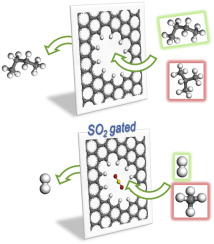Utilizing SO2 as self-installing gate to regulate the separation properties of porous graphenes
Yuanzhen Li, Chao Wu
Index: 10.1016/j.carbon.2018.04.004
Full Text: HTML
Abstract

We theoretically verify the reversible decoration of the pores of two-dimensional membranes to achieve tailorable separation. We show that SO2 molecules can be used as “self-installing”doors to dynamically adjust the pore size of porous graphene sheets. For H atom-passivated porous graphene sheets (e.g. the pore16 model with pore size of 7.9 × 5.9 Å, small molecules such as H2, CO2, CH4 can pass through freely), it can efficiently separate linear alkane molecules from their monobranched isomers (e.g. selectivity of 47500:1 for butane over isobutane). While after a SO2 molecule is strongly adsorbed over pore16 as a partially closed gate, a mixture of smaller molecules like H2/CH4 can be separated successfully, with a selectivity of about 8100:1. The installed molecular gate can be uninstalled by heating, thus the porous membranes can be redecorated to meet the needs of other separation targets. This design principle can be extended to other porous membranes.
|
Selective release of less defective graphene structure durin...
2018-04-09 [10.1016/j.carbon.2018.04.022] |
|
Regeneration of PFOS loaded activated carbon by hot water an...
2018-04-03 [10.1016/j.carbon.2018.04.005] |
|
Enhancement and modulation of photonic spin Hall effect by d...
2018-04-02 [10.1016/j.carbon.2018.03.094] |
|
Computational analysis for the interface mechanics of carbon...
2018-03-31 [10.1016/j.carbon.2018.03.090] |
|
Early stage of CVD graphene synthesis on Ge(001) substrate
2018-03-31 [10.1016/j.carbon.2018.03.092] |